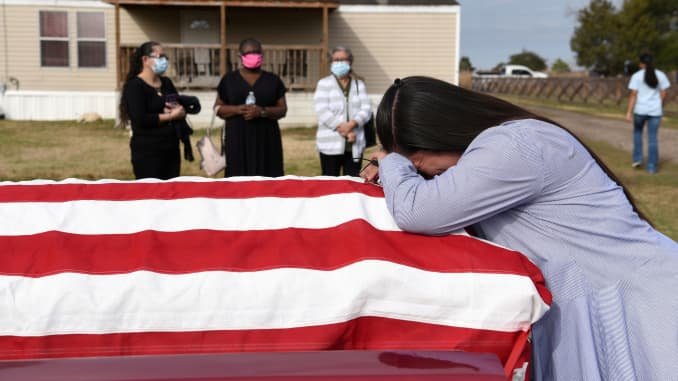The Cost of a "Statistical Life" - Economics, Death, Long Term Impairment and Covid-19
Clearly, it is impossible to place a dollar value on a human life. However, to completely assess the economic effects and impacts of events such as the SARS-CoV-2 pandemic, economists are tasked to do just that. To accomplish this difficult endeavor, economists place a value on "statistical lives" [Koop, Avery. Visual Capitalist. "Putting the Cost of COVID-19 in Perspective". https://www.visualcapitalist.com/putting-the-cost-of-covid-19-in-perspective/. (Accessed May 29, 2021)].
In valuing a "statistical life", economists measure the value or worth of people to reduce their risk of mortality or morbidity. Regulatory policymakers in the United States use this approach as a standard basis for calculating the economic value of a human life, and the same is widely used in discussions concerning global health policies. [see, Jameson D, Summers L, Alleyne G, et al., “Global Health 2035: A World Converging in a Generation,” the Lancet; 382:1898–955(2013). https://www.thelancet.com/journals/lancet/article/PIIS0140-6736 (Accessed May 30, 2021)].
In actuality, there exists a plethora of economic literature concerning "statistical lives", particularly in the area of regulations on the environment and health care. Nonetheless, a single numerical value associated with a "statistical life" is unavailable. Instead, economists use ranges in discussing these values.
The value widely used in environmental and health care discussions on point is assumed to be $10 Million per life [see, Culter, D. and Summers, L. "The COVID-19 Pandemic and the $16 Trillion Virus". https://jamanetwork.com/journals/jama/fullarticle/2771764. (Accessed May 29, 2021). However, in discussions concerning the economic impact of COVID-19, a more conservative value of $7 Million is utilized [id.]. Using this value, economists have calculated the expected economic value lost due to COVID=19 from deaths alone to total a staggering $4.4 Trillion in the period covering November 2020 through November 2021 [id.].
From a health standpoint, unfortunately, the economic costs of the SARS-CoV-2 pandemic does not end with the discussion of death. Individuals infected with COVID-19 who survive are likely to experience significant long term complications resulting from the disease. These complications can include respiratory, cardiac, and mental health disorders, and as well may cause exposure to premature death.
Data from a review of the COVID-19 survivors demonstrates that approximately one-third of those severely or critically exposed to the virus will likely develop a long term impairment. There are approximately 7 times the number of COVID-19 survivors who were severely or critically infected than the deaths resultant from the disease. Based on this assumption, economists suggest that long term impairment may affect more than twice the number of people that died as a result of COVID-19. By assuming a quality adjusted life expectancy reduction of 35%, economists estimate the economic loss from COVID-19 long term impairment to total the sum of $2.6 Trillion for the period November 2020 through 2021. [see, e.g. "The COVID-19 Pandemic and the $16 Trillion Virus", supra.]
The magnitude of this economic loss as a result of solely COVID-19 related deaths and long term impairments is astronomical. Totaling the costs associated with deaths and the costs of long term impairments yields a health related economic loss of $7 Trillion for the period November 2020 through 2021 in the United States alone.
To combat these economic health costs associated with COVID-19 as set forth above, governmental regulatory policies must focus on population testing, contact tracing, isolation, and most importantly vaccinations. Any policy that can demonstrate a material reduction in the spread of this virus should not be overlooked. For even faced with a recovering economy, the United States, and for that matter the rest of the world, will be paying the economic costs of the SARS-CoV-2 pandemic for many future years.
Posted Using LeoFinance Beta


Congratulations @kevinnag58! You have completed the following achievement on the Hive blockchain and have been rewarded with new badge(s) :
Your next target is to reach 1500 comments.
You can view your badges on your board and compare yourself to others in the Ranking
If you no longer want to receive notifications, reply to this comment with the word
STOPCheck out the last post from @hivebuzz:
Support the HiveBuzz project. Vote for our proposal!
Solid article man
I wasn't familiar with the term "statistical life" so it was very informative. I hope we can find a way out of this mess but I agree that we will be paying this bill for many years
Posted Using LeoFinance Beta
Thank you. This was a very interesting project to work on for me. I'm considering a "Part 2" to this expressing the several other associated costs resulting in a mindboggling total economic cost. But that is on the back burner for at least another week or so.
Posted Using LeoFinance Beta
The real problem, in my view, it's not this situation now, ok, it's sad and bad as fu... what is happening, and the actions of some persons don't make this easier... but the next pandemic, that is coming in soon(I think in the next 10 or 20 years top) will make more damages, in the people that survived, and in the social tissue. I said social tissue because we will see people acting as they act now, which means that some conflicts will resurge with more strength. I don't want to get to the details, because I think that is already ok that this post don't go to a messy discussion, but every person can think about what I said and they can infer what they want to infer.